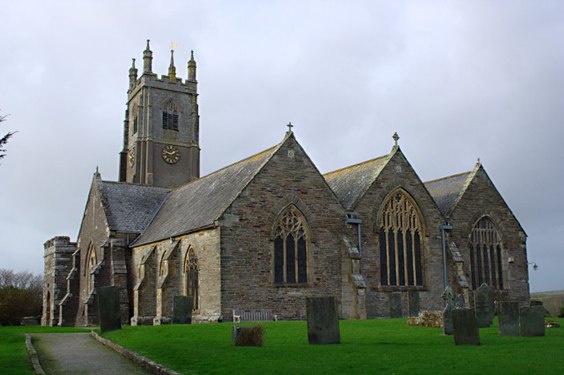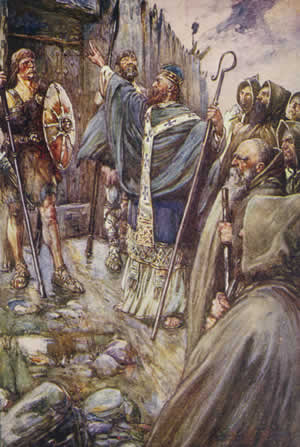
Columba or Colmcille was an Irish abbot and missionary evangelist credited with spreading Christianity in what is today Scotland at the start of the Hiberno-Scottish mission. He founded the important abbey on Iona, which became a dominant religious and political institution in the region for centuries. He is the patron saint of Derry. He was highly regarded by both the Gaels of Dál Riata and the Picts, and is remembered today as a Catholic saint and one of the Twelve Apostles of Ireland.

St Columb Major is a town and civil parish in Cornwall, England, United Kingdom. Often referred to locally as St Columb, it is approximately seven miles (11 km) southwest of Wadebridge and six miles (10 km) east of Newquay The designation Major distinguishes it from the nearby settlement and parish of St Columb Minor on the coast. An electoral ward simply named St Columb exists with a population at the 2011 census of 5,050. The town is named after the 6th-century AD Saint Columba of Cornwall, also known as Columb.
Breage or Breaca is a saint venerated in Cornwall and South West England. According to her late hagiography, she was an Irish nun of the 5th or 6th century who founded a church in Cornwall. The village and civil parish of Breage in Cornwall are named after her, and the local Breage Parish Church is dedicated to her. She is a saint in the Eastern Orthodox Church and Catholic Church.

St Columb Minor is a village in the civil parish of Newquay, on the north coast of Cornwall, England, United Kingdom.
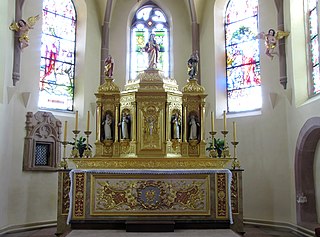
Columba of Sens, was a virgin and nun who was born to a noble pagan family in the northwest of the Iberian Peninsula. She left Gallaecia for Gaul as a child to avoid being denounced as a Christian and received the baptismal name Columba, meaning "dove" in French. She settled in Sens, France, where the Roman emperor Aurelian noticed her and tried to force her to marry his son. When she refused, he imprisoned her. She was protected from being burned alive by a female bear and a miraculous rain shower, but was finally beheaded. Columba was venerated throughout France; a chapel was later built over her relics and the Abbey of Sens, which at one time was a pilgrimage site in her honor, was eventually built there.

Ruthvoes is a village in mid Cornwall, England, United Kingdom. It is in the parish of St Columb Major, about two miles (3 km) south of St Columb Major town and 6+1⁄2 miles (10.5 km) east of Newquay.

Mabyn, also known as Mabena, Mabon, etc., was a medieval Cornish saint. According to local Cornish tradition she was one of the many children of Brychan, king of Brycheiniog in Wales in the 5th century. The village and civil parish of St Mabyn is named for her, and the local St Mabyn Parish Church is dedicated to her.

Ia of Cornwall was an evangelist and martyr of the 5th or 6th centuries, flourishing in the area of St Ives, Cornwall. She is said to have been an Irish princess, the sister of Erc of Slane.
Juthwara or Jutwara was a virgin and martyr from Dorset. According to her legend, she was an eighth-century Saxon, and sister to Sidwell, though some historians have theorised she was a Briton living in the sixth century. Her relics were translated to Sherborne during the reign of Ethelred the Unready. Nothing further is known with certainty about her life.
Wyllow was a Cornish hermit saint and martyr whose existence was reported by William Worcester.
Nickanan Night is a Cornish feast, traditionally held during Shrovetide, specifically on Shrove Monday.

Saint Piran's Day, or the Feast of Saint Piran, is the national day of Cornwall, held on 5 March every year. The day is named after one of the patron saints of Cornwall, Saint Piran, who is also the patron saint of tin miners.
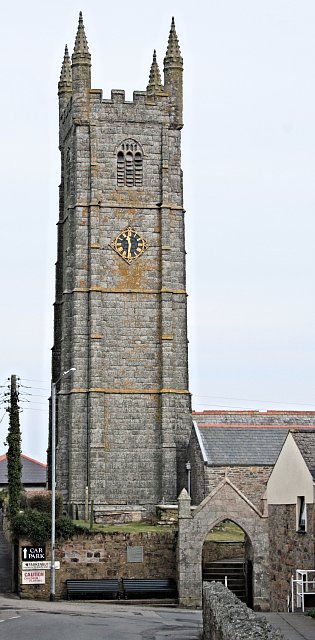
St Columb Minor Church is a late 15th-century Church of England parish church Diocese of Truro in St Columb Minor, Cornwall, United Kingdom
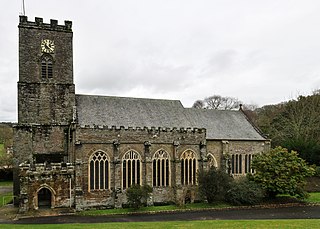
Christianity in Cornwall began in the 4th or 5th century AD when Western Christianity was introduced as in the rest of Roman Britain. Over time it became the official religion, superseding previous Celtic and Roman practices. Early Christianity in Cornwall was spread largely by the saints, including Saint Piran, the patron of the county. Cornwall, like other parts of Britain, is sometimes associated with the distinct collection of practices known as Celtic Christianity but was always in communion with the wider Catholic Church. The Cornish saints are commemorated in legends, churches and placenames.
Saint Senara, also known as Asenora, Sinara, or Sennara, is a legendary Cornish saint with links to the village of Zennor on the north coast of Cornwall, UK. The Church of Saint Senara, Zennor is dedicated to her, and according to legend her name inspired the name of the village of Zennor along with local features like Zennor Head and Zennor Quoit.
Adwen or Adwenna i purported to have been a 5th-century Christian virgin and saint. According to historian Nicholas Orme, Adwen was identified in the original tradition as a brother of Nectan of Hartland, but subsequently misclassified by Charles Henderson in the 18th century as female.

Tetha, also known as Teath, Tecla, and by a variety of other names, was a 5th-century virgin and saint in Wales and Cornwall. She is associated with the parish church of St Teath in Cornwall. Baring-Gould gives her feast day as 27 October, but this has been called a mistaken conflation with Saint Ia. In 1878, it was held on the movable feast of Whit Tuesday. Other sources place it on 1 May, 6 September, and (mistakenly) 15 January. It is no longer observed by either the Anglican or Catholic church in Wales.
The following is a timeline of the history of St Columb Major, Cornwall, England, United Kingdom.

St Columba's Church is a 14th-century, Grade I listed parish church in the Church of England Diocese of Truro in St Columb Major, Cornwall. In 1860 plans were drawn up by William Butterfield, in hope of St Columb church becoming the cathedral of the future diocese of Cornwall, but the cathedral was built at Truro. A second church dedicated to the same saint is known as St Columba's Church, St Columb Minor.

